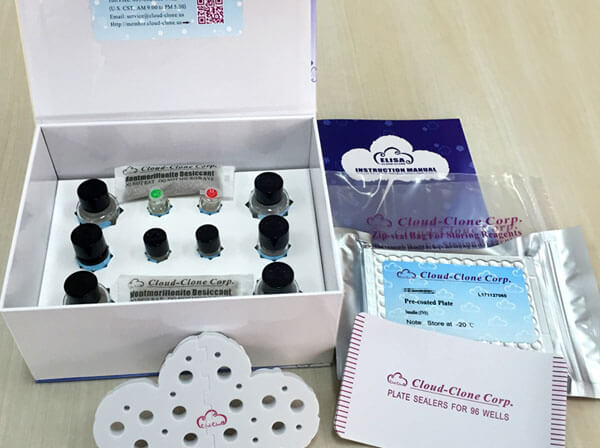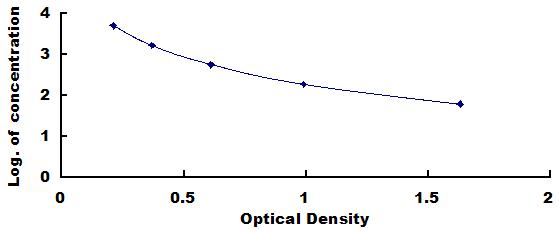ELISA Kit for Immunoglobulin G1 (IgG1) 

IGHG1; Ig Gamma-1 Chain C Region; Immunoglobulin Heavy Constant Gamma 1; G1m Marker; Immunoglobulin Gm1
- UOM
- FOB US$ 529.00 US$ 756.00 US$ 3,402.00 US$ 6,426.00 US$ 52,920.00
- Quantity
Overview
Properties
- Product No.CEA074Bo
- Organism SpeciesBos taurus; Bovine (Cattle) Same name, Different species.
- ApplicationsEnzyme-linked immunosorbent assay for Antigen Detection.
Research use only - DownloadInstruction Manual
- CategoryImmune molecule
Sign into your account
Share a new citation as an author
Upload your experimental result
Review

Contact us
Please fill in the blank.
Recovery
Matrices listed below were spiked with certain level of recombinant Immunoglobulin G1 (IgG1) and the recovery rates were calculated by comparing the measured value to the expected amount of Immunoglobulin G1 (IgG1) in samples.
| Matrix | Recovery range (%) | Average(%) |
| serum(n=5) | 98-105 | 102 |
| EDTA plasma(n=5) | 89-103 | 94 |
| heparin plasma(n=5) | 79-89 | 86 |
Precision
Intra-assay Precision (Precision within an assay): 3 samples with low, middle and high level Immunoglobulin G1 (IgG1) were tested 20 times on one plate, respectively.
Inter-assay Precision (Precision between assays): 3 samples with low, middle and high level Immunoglobulin G1 (IgG1) were tested on 3 different plates, 8 replicates in each plate.
CV(%) = SD/meanX100
Intra-Assay: CV<10%
Inter-Assay: CV<12%
Linearity
The linearity of the kit was assayed by testing samples spiked with appropriate concentration of Immunoglobulin G1 (IgG1) and their serial dilutions. The results were demonstrated by the percentage of calculated concentration to the expected.
| Sample | 1:2 | 1:4 | 1:8 | 1:16 |
| serum(n=5) | 79-98% | 87-101% | 78-103% | 78-98% |
| EDTA plasma(n=5) | 92-99% | 79-102% | 92-99% | 89-101% |
| heparin plasma(n=5) | 91-103% | 93-101% | 80-95% | 97-104% |
Stability
The stability of kit is determined by the loss rate of activity. The loss rate of this kit is less than 5% within the expiration date under appropriate storage condition.
To minimize extra influence on the performance, operation procedures and lab conditions, especially room temperature, air humidity, incubator temperature should be strictly controlled. It is also strongly suggested that the whole assay is performed by the same operator from the beginning to the end.
Reagents and materials provided
| Reagents | Quantity | Reagents | Quantity |
| Pre-coated, ready to use 96-well strip plate | 1 | Plate sealer for 96 wells | 4 |
| Standard | 2 | Standard Diluent | 1×20mL |
| Detection Reagent A | 1×120µL | Assay Diluent A | 1×12mL |
| TMB Substrate | 1×9mL | Stop Solution | 1×6mL |
| Wash Buffer (30 × concentrate) | 1×20mL | Instruction manual | 1 |
Assay procedure summary
1. Prepare all reagents, samples and standards;
2. Add 50µL standard or sample to each well.
And then add 50µL prepared Detection Reagent A immediately.
Shake and mix. Incubate 1 hour at 37°C;
3. Aspirate and wash 5 times;
4. Add 90µL Substrate Solution. Incubate 10-20 minutes at 37°C;
5. Add 50µL Stop Solution. Read at 450 nm immediately.

Test principle
This assay employs the competitive inhibition enzyme immunoassay technique. An antibody specific to Immunoglobulin G1 (IgG1) has been pre-coated onto a microplate. A competitive inhibition reaction is launched between Horseradish Peroxidase (HRP) labeled Immunoglobulin G1 (IgG1) and unlabeled Immunoglobulin G1 (IgG1) (Standards or samples) with the pre-coated antibody specific to Immunoglobulin G1 (IgG1). After incubation the unbound conjugate is washed off. The amount of bound HRP conjugate is reverse proportional to the concentration of Immunoglobulin G1 (IgG1) in the sample. After addition of the substrate solution, the intensity of color developed is reverse proportional to the concentration of Immunoglobulin G1 (IgG1) in the sample.
Giveaways
Increment services
Citations
- The Effect of CXC Motif Chemokine 13 on Hepatocellular Carcinoma Associates with Wnt SignalingHindawi:Source
- Beneficial effect of T follicular helper cells on antibody class switching of B cells in prostate cancerPubmed:25529861
- IgG autoantibody subclasses altered in immuno-related hemocytopeniaPubmed:25666506
- The Effect of C-X-C Motif Chemokine 13 on Hepatocellular Carcinoma Associates with Wnt SignalingPubMed: 26161394
- Oral administration of Clostridium butyricum CGMCC0313‐1 reduces ovalbumin‐induced allergic airway inflammation in micepubmed:28250847
- Icariin stimulates osteogenic differentiation of rat bone marrow stromal stem cells by increasing TAZ expressionpubmed:28486190
- Oral administration of Clostridium butyricum CGMCC0313-1 reduces ovalbumin-induced allergic airway inflammation in micepubmed:28122397
- Adipose Tissue-Derived Mesenchymal Stem Cell Modulates the Immune Response of Allergic Rhinitis in a Rat ModelPubmed: 30781605
- Optimized GAPDH-truncated immunogen of Streptococcus equi elicits an enhanced immune response and provides effective protection in a mouse model33647714
- The suppression of Brd4 inhibits peripheral plasma cell differentiation and exhibits therapeutic potential for systemic lupus erythematosus

















